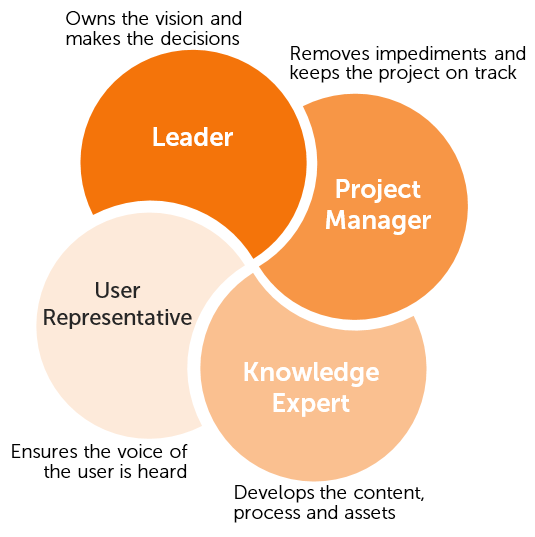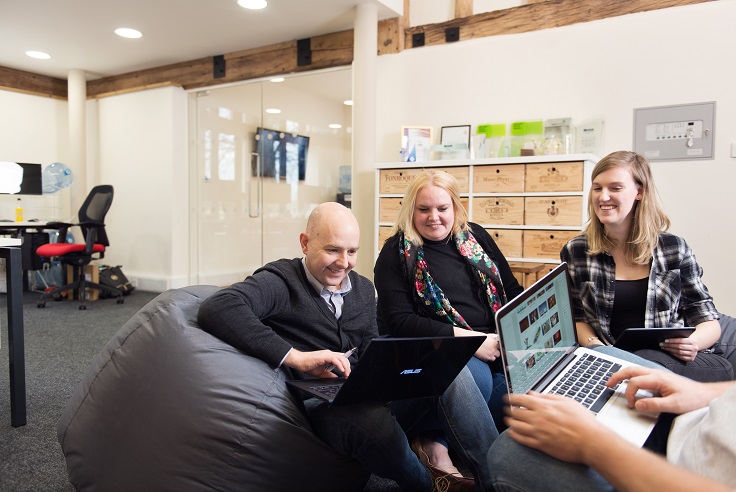So far we've looked at when you would use Agile, the team you need, sprints, meetings, tools other considerations for Agile development for Pharma. Now we will be looking at a case study.
Case study: HCP and Patient website
Let’s take as an example, a website for a product launch. It will be required to have both an area for healthcare professionals (HCPs) and one for patients. It will not be required to collect information about individuals (reducing security and GDPR issues) but will have a chatbot to make it easier for the website users to get to the information they require. The vision is not just for a boring ‘text and a few images’ website but something with more visuals, some video content and downloadable, printable leaflets. Therefore, the design will have some complexity, the development will be relatively straightforward, but the content needs to be produced in conjunction with representative HCPs and with a patient group’s involvement. The website will be designed and built by an external agency and is likely to be launched in three phases:
Phase 1: HCP website only
Phase 2: Include the patient parts of the website
Phase 3: Include chatbot and downloadable leaflets
This is how we might score this:
How complex is the project?
Well, it is considerably more complicated than a leave piece or an e-Detail and will need to work on mobile devices too. It won’t be collecting user data and only needs to work in a single jurisdiction which will make compliance easier so we would score it as a +1.
How much creativity will be needed to arrive at the solution?
As this will have multiple pages, multiple videos, imagery, different audiences, new content and there are no design assets to start with, then we might rate this as requiring a lot of creativity so would score this as a +2.
How well developed is the process from beginning to end of the project?
The company does not have a process for doing websites but has tried and tested processes for approval. However, the agency has designed and delivered many websites before and so has a tried and tested process to follow. This will have to be adapted but will serve as a helpful framework. We might score this as a 0.
How many people will be involved in the project in a substantial capacity?
This is where some challenges are likely to lie. In order to deliver this project successfully, we believe that there will need to be significant involvement from a Project Manager, Brand Manager, medic, legal representative, Multi-channel Manager, various people from the agency, a freelance Copywriter and representatives from HCPs and a patient group. This is quite a lot of people so we would score this as a +2.
How important is it to have customer input to deliver a successful outcome?
As this is a solution for HCPs and for patients, it will be absolutely imperative to have representation from both groups involved at all stages of the project from concept, through design and testing stages and throughout all three phases of the project. We would therefore score this as a +2.
How long do you expect the project to take to complete successfully?
The project team has an ambition to launch the first phase within three months and phase 2 and 3 within six months. This is seen as quite an aggressive timeline but possible if the team is nimble and efficient. We therefore score this as a +1. So, the overall score is +8. This is certainly on the Agile side of the spectrum. However, what does this practically mean? Here is what we might do with this thinking when deciding how to set up a project like this:
Sprint length
For projects like this, we would normally recommend Sprints are no less than one week, and no more than four weeks. Often, we are thinking that a minimum of three sprints in any project makes practical sense. In this case study, as you are expecting 13 weeks minimum to launch the first phase and then another 13 weeks, we would probably start with two-week sprints and see how it goes and shorten if required.
Core project team

On our core project teams, we would recommend the following:
- Decision maker from the business
- Project Manager from the business
- Project Manager from the agency
- HCP representative
- Patient group representative (maybe only from phase 2)
- Designer (only while there are design activities in the Sprint) from the agency
- Technical Lead from the agency
- Medical representation from the business
This may sound like a lot, but we would not expect everyone to attend all meetings: The only meeting where everyone would be invited would be the Sprint Review meeting which may be as short as 30 minutes every sprint. If you can’t spare 15 minutes a week to a project this complex and important as the medic responsible for sign off, then I would suggest you have a resourcing problem that needs fixing.
Core team meetings

We would recommend the following meetings every Sprint:
Sprint Planning meeting
30 minutes at the beginning of a Sprint
Sprint Review meeting
30 minutes at the end of the Sprint
Retrospective
15 minutes at the end of a Sprint
Stand-ups
10 minutes, 3 times a week at 9:15am on a Mon, Weds and Fri
We would recommend putting the Sprint Review and Retrospective meetings together in one meeting on a Friday at 3pm and the Sprint Planning meeting at 9:30am on the following Monday (straight after the stand-up).
Other considerations
Kanban board
We suggest using a digital version like Microsoft Planner.
Gantt charts
We don’t feel this is necessary but may change if stakeholders ask for it.
Chat solution
We suggest using Microsoft Teams.
Estimation
As there are lots of unknowns, we suggest using Story Points and Planning Poker.
Definition of Done
We will start without this and see whether alignment becomes an issue.
If you are interested in how an agile mindset might help you be more productive as a team, visit earthware.co.uk/agile or drop us a line.


